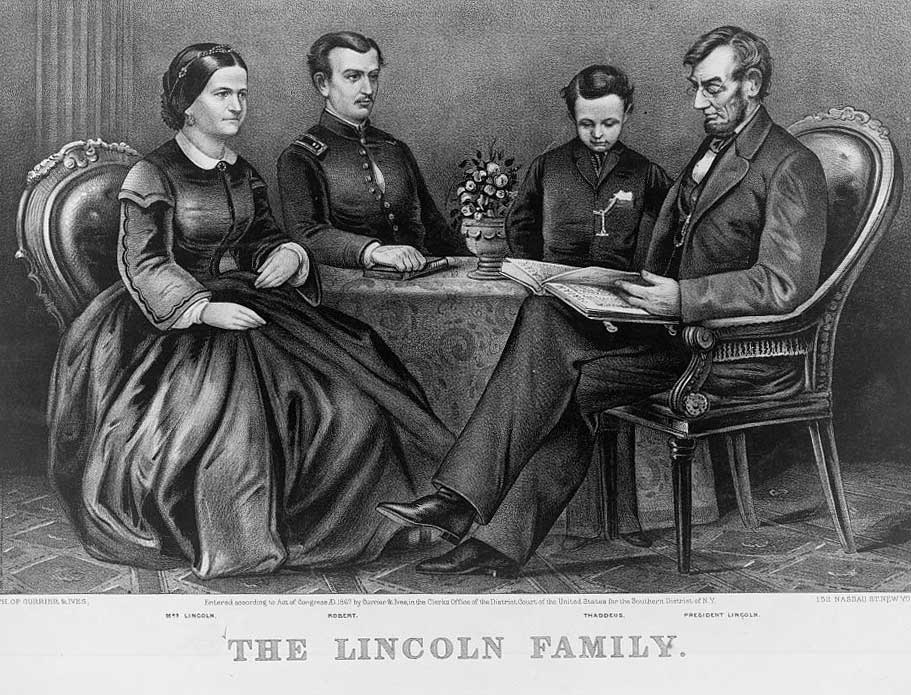The wife of President Abraham Lincoln, Mary is perhaps one of the top three best-known First Ladies, she is certainly in the top five. Very few people don’t know at least a cursory bit about her, and most know her name. She has a very special place in American history for a variety of reasons.
Born December 13, 1818, in Lexington, Kentucky, Mary Ann Todd was the fourth of seven children born to Robert Smith Todd and Elizabeth Parker. Her father was a prosperous banker, and the family was consequently able to own slaves, which gave Mary a very comfortable and pampered childhood, with slave servants to attend to her every need and command. However, Mary’s mother died when she was six, and her father remarried to Elizabeth Humphreys when Mary was eight. Her father and step-mother had nine more children together, and Mary’s relationship with her step-mother was a noted difficult one.
When she was 14, Mary and her family moved to a 14-room mansion in Lexington, which is today known as the Mary Todd Lincoln House. She attended Madame Mantelle’s Finishing School to attain the education expected of refined Southern ladies. At the school, Mary became fluent in French and well-versed in literature. She also learned dance, acting, and the social manners expected of a young girl of her status in society.
By the time she left school, she was regarded as witty, highly educated and intelligent, and with an excellent grasp of politics. She identified as part of the now-defunct Whig political party before her marriage, as did the rest of her family.
When Mary was 21, she moved to Springfield, Illinois to live with her sister Elizabeth and Elizabeth’s husband, Ninian Edwards. Mary became popular among the gentile people of Springfield and was courted by many young men, including politician Stephen Douglas (who campaigned against Abraham Lincoln for President of the United States in the now-famous Lincoln-Douglas Debates). However, she ultimately chose a fellow Whig to marry from among her plentiful suitors… Abraham Lincoln.
Mary and Abraham married when Mary was 23, on November 4, 1842, at her sister Elizabeth’s home in Springfield. Abraham was already involved in politics, and while he continued his political career, Mary managed their household, which eventually included four sons. Robert, Edward, William, and Thomas (“Tad”) were all born to the couple, though only Robert and Thomas lived past childhood. Both Robert and Thomas outlived Abraham, but only Robert outlived Mary.
Edward died when he was four, of tuberculosis. William (“Willie”) died of typhoid while Lincoln was president when he was 12.
The house where Abraham and Mary lived from 1844 to 1861 is still standing and is designated as the Lincoln Home National Historic Site. In between political gigs, Lincoln worked as a circuit lawyer, and Mary was often left home without him for months at a time. She spent her time managing their household and raising their children. She was also her husband’s biggest supporter and promoter at all times, both socially and politically. She ramped this support up a notch when he became president. Few First Ladies have championed their husbands in this office as did Mary.
Though she was busy doing everything she could to support and promote Abraham in the White House, the years they spent there were not easy ones, both politically and personally. The major issue for them, of course, was that the Civil War began shortly after Abraham’s inauguration. Mary had a particularly hard time on the personal level because her family was from a border state, one that allowed slavery, but bordering others that didn’t. Several of her brothers served in the Confederate Army, while at least one is said to have served in the Union Army. Some of her half-brothers were killed fighting for the Confederacy. She was living the oft-told tale of families being torn apart by being on opposite sides during the Civil War.

Currier & Ives lithograph of United States President Abraham Lincoln with his wife, Mary Todd Lincoln, and his sons, Robert and Thaddeus Lincoln. Wikipedia
During the war, Mary did all she could to be a good hostess and First Lady to Abraham, but it wasn’t easy. Though she grew up in a refined area of Kentucky, she was considered to be “western,” and Abraham, from Illinois, was considered the first “western” president. Washington, D.C. high society was, at the time, composed of mainly southern and eastern people, and Mary was often criticized for being “coarse” in her manners and pretentious in her attitude.
She had difficulty navigating all the political rivalries in Washington, opportunistic job seekers, and scandal-seeking newspapers (the media was an issue even then). She didn’t help her public image when she extensively re-decorated the White House and bought new china during the war. Even Abraham was angry with her for it, though Congress eventually appropriated the money to cover her expenses to the president’s house.
Mary was also known for having a terrible temper, emotional outbursts (some in public during Abraham’s presidency), long periods of depression, migraines which became worse after a carriage accident, and a habit of overspending. Many modern historians believe she suffered from bipolar disorder, though there are alternative opinions, such as one pointing to her symptoms as indicative of pernicious anemia.
On the other hand, she was kind, caring, and compassionate, visiting many hospitals during the war to give gifts of fruit and flowers to wounded soldiers, and even took time to write letters for them to send home to their families. She also accompanied Abraham to battlefields every now and then.
After Abraham’s assassination shortly after the war ended, Mary was nearly mad with grief, so much so that the doctor attending the shot Abraham ordered her out of the room, and their son Robert sat with Abraham all night until he died from the wound. Mary received many letters of condolence from around the world, including one from Queen Victoria, who had lost her own husband four years earlier and tried to answer as many of them personally as she could.
Though grief-stricken, she tried to maintain a normal life with her sons and successfully petitioned Congress for a pension of $3,000 a year, which was approved by a low margin because of all the Congressmen she had alienated while First Lady. It was only in 1871, when her 18-year-old son Thomas “(“Tad”) died of either pleurisy or tuberculosis (historians cannot agree on this) that she became completely unhinged. She became obsessively overprotective of Robert, was paranoid, and kicked up her spending to insane levels by buying things she would never use (spending seemed to be mentally therapeutic for her).
Concerned about the public embarrassment she may cause him, Robert successfully petitioned the court to have Mary committed to a mental institution in 1875. She became despondent and attempted suicide by laudanum, but the pharmacist she tried to buy it from was so concerned about the amount she was buying, he sold her a placebo. Mary had not lost her mind, however. She was still quite crafty.
Only three months after being committed, she wrote letters to her lawyer and his wife (who was a feminist lawyer) about her situation and smuggled them out of the institution to them. She also wrote to the editor of the Chicago Times. Soon, her situation became public, and the embarrassment Robert hoped to avoid hitting him. He went back to court to have her removed from the institution, though a doctor there testified he believed Mary would benefit from his treatment. Eventually, Mary was released and allowed to go back to Springfield to live with her sister, Elizabeth, which is exactly what she wanted.
Robert’s motives in having Mary committed were publicly questioned, as he controlled her estate and money. A year after being released, she was declared competent to handle her own financial affairs, and she became estranged from Robert, with whom she was extremely angry.
Mary spent the next four years traveling and even lived in France for a while. Cataracts, which made her susceptible to falls, and declining health, forced her to return to Springfield, where she died in 1882, only being reunited with Robert shortly prior to leaving this world. She was buried beside her beloved husband, Abraham.
Mary’s only grandchildren were from Robert, who had two daughters and a son. His son died at age 16, but his daughters had children. The last known direct descendant of Abraham and Mary died in 1985, a great-grandson of theirs through Robert. However, there is a question of whether a great-great Lincoln grandson exists. The great-grandson, who died in 1985, was married three times, and the second wife announced she was pregnant just a few months after their marriage. The great-grandson, Robert Todd Lincoln Beckwith, claimed to have had a vasectomy six years prior to the marriage and claimed the child was the result of adultery and initiated divorce proceedings. His soon-to-be ex-wife claimed him as the father on her son’s birth certificate, despite Robert offering her money not to. The court ordered a blood test on the boy, which she refused to submit him to, so the court declared Robert was not the father.
However, Robert left considerable sums of money to many charities and institutions in the event he had no heirs. All of his beneficiaries gave substantial payouts to his supposed son so that he would not make further claims on them for the Lincoln inheritance. The maybe Lincoln great-great-grandson, who is now 48 years old, lives in Florida, where he works as a lawyer and refuses to give interviews.






